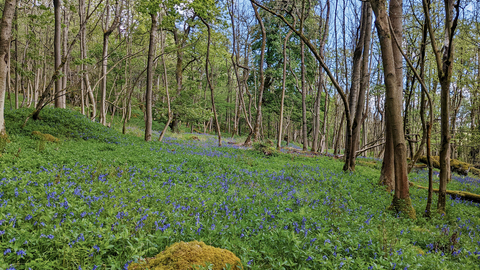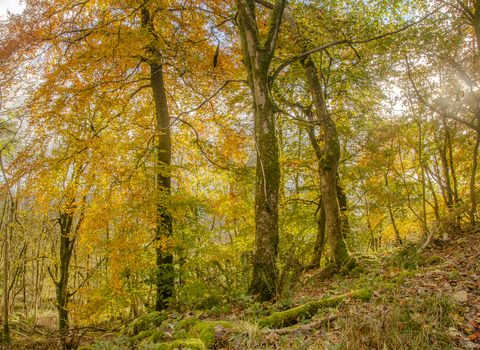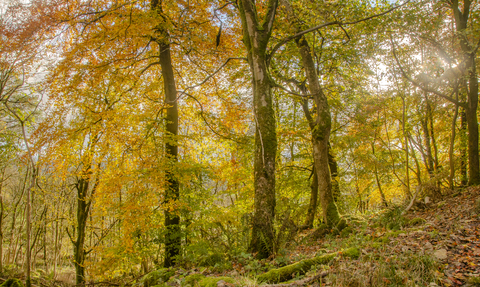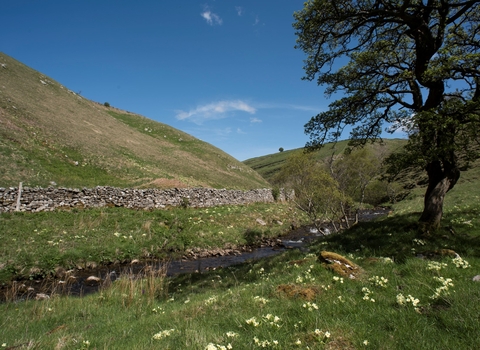
Bluebell Carpet, Grass Wood - (C) Joe Bodycote
Grass Wood Nature Reserve
Location
Know before you go
Dogs
When to visit
Opening times
Open at all times. We recommend a half day trip for this reserve, but for a longer visit why not try the five-mile circular walk from Grassington.Best time to visit
March to May, September to OctoberAbout the reserve
A short walk up the valley from the popular village of Grassington, Grass Wood is one of the largest areas of broadleaved woodland in the Dales. It’s chiefly an ash woodland, growing on a series of limestone terraces, with open glades and exposed rock.
Yorkshire Wildlife Trust has been involved in Grass Wood since the 1960s and took ownership from the Forestry Commission in 1983. We work with a very active group of volunteers to manage the reserve, removing non-native trees and initially replanting these areas, which we now leave to regenerate naturally.
Some of the plant species you might find include bird’s-nest orchid, horseshoe vetch, wild basil, spring sandwort and green spleenwort, along with commoner species like lily-of-the-valley, lady’s mantle and rock rose. Autumn is the season for a fascinating array of fungi, including the distinctive common puffball.
With a discerning eye for butterflies, you might be lucky enough to spot the northern brown argus, a small, chocolate-brown butterfly at the southern edge of its British range, among the speckled woods and ringlets.
Contact us
Environmental designation

Autumnul Grass Wood (c) Sara
Want to visit Grass Wood from the comfort of your own home?
We are lucky to look after an incredible range of nature reserves from the rolling hills of the Dales to the white cliffs of the coast.
Unfortunately, some of our reserves are not easily accessible for everyone.
Instead, why not take this virtual tour around Grass Wood and discover some of its best-kept secrets - from the comfort of your own home! Just hit 'slideshow' on the top right to get started.
About
Grass Wood is of high value due to the diversity of plant and animal species it supports. It is predominantly an ash woodland that is growing on a series of limestone terraces, with much exposed rock, creating open areas within the wood.
Plant species of particular interest, albeit that they are rare within the wood, include bird's nest orchid, horseshoe vetch, wild basil, spring sandwort and green spleenwort. More commonly seen species include lilly-of-the-valley, lady's mantle, melancholy thistle and rock rose.
The woodland supports a good range of common bird species including chaffinch, tawny owl and green woodpecker. Migrants include the pied flycatcher, spotted flycatcher and redstart.
Seasonal highlights
- Spring: Plants - Bluebell; Primrose; Lily-of-the-valley; Birds - Pied flycatcher; Spotted flycatcher; Willow Tit; Willow Warbler
- Summer: Plants - Dropwort; Bloody Cranesbill; Invertebrate; Northern Brown Argus
- Autumn: Fungi - Common puffball; Milkcap; Brittlegills; Clouded funnel cap; Mammals - Roe deer; Bats
- Winter: Birds - Tawny Owl; Nuthatch; Treecreeper
History
The Trust originally became involved with the site in the 1960s and finally took ownership from the Forestry Commision in 1983.
The Trust have since worked with a very active group of volunteers to manage the reserve, removing non-native trees and initially replanting these areas, but now they are left to regenerate naturally.
Directions
Public transport
The nearest bus service goes to Grassington, approximately a 1 mile walk, with the nearest rail station at Skipton.
By car
From the B6265 in Grassington take Wood Lane on your right and travel north. Follow this for one mile, the nature reserve lies alongside the Grassington and Conistone minor road.
Ash dieback disease
Ash dieback disease is having a significant impact on the Ash trees in Grass Wood.
Please be aware that tree felling will take place this winter to ensure safe visitor access on the reserve. We understand that this may be alarming - we explain why below.
Please observe and respect notices on site for your own safety.
Ash dieback is a disease of Ash trees caused by the fungus Hymenoscyphus fraxineus, first detected in Britain in 2012. There are confirmed infections in most regions of the UK, including Yorkshire.
Symptoms include leaf loss, crown dieback and bark lesions, which directly and indirectly lead to the death of the tree. Current research warns that less than 1% of our native Ash trees will be effectively resistant to the disease, therefore the impact on our landscape will be profound.
Unfortunately, we cannot stop the spread of the disease. There are many factors which may contribute to how quickly and how drastically it will affect woodlands and individual trees. This makes it difficult to plan a response except in general terms – we cannot be more specific until the disease begins to have a visible impact on our nature reserves.
Over the coming few winters we will be starting to fell dead or dying Ash trees that are within reach of the public footpath, the main access track through the wood, and the road. This is because they potentially pose a risk to the public if they were to shed limbs or fall completely.
It is important to re-emphasise that in all other areas of the woodland our aim is non-intervention, leaving dead and fallen Ash trees as good habitat for other wildlife.
This will also give us a chance to assess the vast majority of trees for resistance to the disease although sadly, at present, this looks exceptionally rare. Identifying resistant trees may also enable us to promote regeneration of Ash by protecting healthy seedlings and/or collecting seed and growing these on for future replanting schemes.
Green huntsman spider
More than a fairy-tale
Grass Wood is the only known location in all of Yorkshire where the green huntsman spider has ever been recorded. This large, colourful spider was first documented here over a century ago, but has not been recorded on site in over 35 years (August 1988).
To spot a spider
Female green huntsman spiders have a body length between 10-15 mm. From mid-summer onwards females sew several leaves (often of scrub oak) together and, within the retreat, produce and guard a large egg sac containing green eggs.
Males are significantly smaller and more colourful, measuring between 7-10mm with a red and yellow abdomen.
On the hunt for a huntsman!
If you encounter a wandering spider, or discover a female with her eggs, please take a photograph, note where you are (10-figure GPS co-ordinates if possible) and email the information to geoff.oxford@york.ac.uk.

Grass Wood Volunteers enjoyed a well-earned rest - Photo take by Sara
Volunteer at Grass Wood
Join us at Grass Wood for practical conservation task days, all ages welcome!
Email us at volunteering@ywt.org.uk or call the volunteering support team on 01904 659570
Did you know?
Although green woodpeckers nest in trees, they spend most of their time on the ground, eating ants.

The autumn colours were even more beautiful when the sun came out
Photo Credit - Telling our Story Volunteer, Sara



